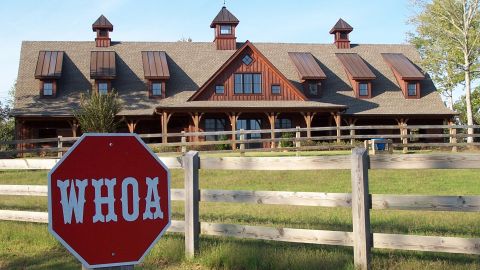
Sign of the times: Property owners at high-end, high-amenity communities like The Cliffs could wind up owning equestrian centers and other facilities in the event of developer defaults.
In the early years of the housing crisis, homes at the low end of the market got most of the ink as the media tried to rationalize its ignorance of sub-prime mortgage lending and the irrational exuberance it had fed. But now we can expect more and more reports about troubles at the high end, especially in the wake of The Cliffs Communities request to property owners for $60 million in financing, a story we broke here at Golf Community Reviews.
Many of the properties at The Cliffs, as well as at the ill-fated Ginn Resorts and other upscale
Owners of expensive vacation homes may lie awake at night wondering what to do with their under-water properties.
developments, were designed as trophy homes for wealthy families whose incomes and stock portfolios could justify and sustain multi-million properties. During one of my visits to the Cliffs, for example, a sales agent pointed at one 6,000 square foot behemoth and said it was the owners’ third home, and that they planned to use it for family gatherings about four weeks a year. They paid more than $3 million to build it.
Okay, they had it, they flaunted it. Low interest rates made it easier to finance these vacation spots, either through straight-up mortgages or by dipping into the equity in primary homes to make down payments on the vacation homes. But these formerly wealthy owners are in a tight spot now, as the thought of paying for a lightly used, financially under-water property keeps them up at night. This is why the inventory of high-priced homes in the leisure residential market is growing fast, and prices are dropping.
The law of supply and demand, of course, rules the real estate market, and it is hard to see the top end of the market rebounding anytime
Inventories will remain high at the high end as owners of some expensive vacation homes refuse to settle for true market value offers.
soon, what with a growing inventory of McMansions and the loss of appetite for debt and risk in an uncertain climate. Supply at the high end will remain high for at least the next couple of years as publicity about financial issues, such as at The Cliffs, breeds anxiety, and many owners of homes they bought for $2 million are reluctant to price them at true market value which, in some cases, is 50% of what they paid originally.
That reluctance notwithstanding, extreme bargains are starting to emerge in places like The Cliffs and other high-end communities, with a few foreclosures and short sales sprinkled in to put additional pressure on selling prices (a short sale is one in which the owner arranges with his mortgagee to sell for less than the house is worth). Those who have navigated through the down economy in good shape and have an appetite for a big vacation or retirement home could be looking at homes that cost $300 a square foot to build now available at a price somewhere in the $200 range, or even less.
Tempting though that may be, a bargain price of $1.2 million for a property that originally cost, say,
The safest purchases are likely to be in those high-end communities where amenities were turned over to owners some years ago.
$2 million is no bargain if the developer defaults before all the promised amenities are built. That is why those looking to take advantage of bargains at the high end need to proceed carefully and focus primarily only on communities in which all amenities are in and, ideally, where the owners are in charge of the amenities and maintenance costs are easy to understand and stable.
At The Cliffs, developer Jim Anthony has pledged the golf courses, clubhouses and the community’s other upscale amenities as collateral. Anyone who has visited The Cliffs or lives there knows just how tasteful, sophisticated and richly appointed the equestrian centers, clubhouses, wellness centers and other facilities are. But current and future owners at The Cliffs need to consider that the developer has subsidized those amenities for nearly 15 years. One of The Cliffs’ property owners told me that Anthony has opened his books for a full accounting. As they scrub those books, the owners’ representatives should pay careful attention to just how much it will take, in the event of default, to pay for the lush amenities. In that way, they can assure their fellow residents (future Cliffs bondholders) that the “inheritance” taxes will not put them in an even more precarious position. Future owners who don’t ride horses or work out on expensive fitness equipment should consider seriously how much they want to subsidize such amenities. Those amenities and their host communities aren’t worth what they once were.
If you want more information about The Cliffs or any other communities in the southern U.S., please contact me. 























